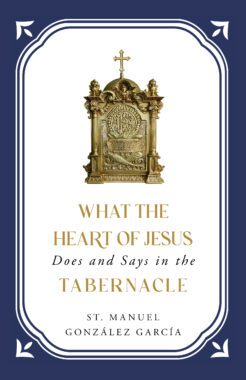Here is a question that will leave more than a few Christians, and I will even say pious ones, perplexed: What does the Heart of Jesus do and what does it say?
They had not taken into account that in the Tabernacle there is someone who can speak and speaks, someone who can work virtue in the Tabernacle!
Isn’t it true that for many Christians, the idea of the Tabernacle is this: a place of great respect because a very high, great, powerful Lord lives there, all majesty, but very quiet and still? It’s not that they don’t believe that Jesus Christ is entirely present in the Tabernacle, just as He is in Heaven. They certainly believe that He is there with divinity, soul, body, and therefore with eyes that see, ears that hear, hands that can move, and a mouth that can speak.
Yes, they have faith in all of this, but it’s a faith that remained only in their minds and didn’t descend into their hearts, let alone their feelings. It’s a faith that, by staying stagnant there, has barely turned into the light of that life, into a criterion, into warmth, into love, into intimate conviction, into enthusiasm, into an impetus for action and decisive action.
This faith experience is much like the seeds of large plants sown in small pots. No matter how fertile the seed is, no matter how much water and light you give it, if you don’t provide the roots with soil and room to expand, you will only get a stunted and shriveled plant.
And there are Christians who do the same with their faith, so they drown it in their routine way of seeing, understanding that, without denying that they have faith, it barely shows signs of life and influence. I have long been convinced that the problem with many people is not that they don’t know good things but that they don’t realize the good things they already know. There is much ignorance—and in matters of religion, it is an appalling ignorance—but despite being so vast, there is much more what I would call a lack of realization. Practically speaking, I believe that the lack of realization is a more frequent cause of religious indifference and all kinds of public and private sins, which we lament today, than the lack of knowledge.
Most Christians who live without fulfilling any of the precepts imposed by their religion know that they have an obligation to attend Mass on Sundays and holidays, to confess and receive Communion once a year, and so on. All of them have faith in the Mass, in Confession, in Communion, in the teaching authority of the Church, and yet they don’t practice it, nor are they disturbed by not practicing it.
I think their problem is that they have placed their faith in the pot of their routines, their conveniences, their idiosyncrasies, their selfishness—yes, I said the word, their selfishness—because this is the thing interested in keeping faith enclosed and stifled in the soul.
Just as humility and charity, if not wisdom, are the elements that best prepare for receiving and fostering it, pride and self-love, which are the components of selfishness, hinder, render useless, and paralyze acquired knowledge. The remedy, therefore, lies in trying to shatter that pot so that faith, like the roots of a captive plant, can spread freely throughout the soul and become love, deeds, and habits of upright Christian life.
Nowhere is this lack of realization more evident than in the behavior of Christians regarding the Holy Eucharist. Everyone knows what is there, but how few take notice!
How happy I would be if I could awaken in some Christians, through my writings, the sense of realization about the Eucharist! How happy I would be if as a result of these readings, some Christians would rise determined to go to the Tabernacle to see what is done there and to hear what is said there by the most loving and steadfast of our lovers! Because, Christians, know this: the Heart of Jesus in the Tabernacle is neither silent nor idle.
+
This article on Understanding the Heart of Jesus in the Tabernacle is adapted from the book What the Heart of Jesus Does and Says in the Tabernacle by St. Manuel González García which is available from Sophia Institute Press.
Art for this post on a reflection from “What the Heart of Jesus Does and Says in the Tabernacle” by St. Manuel González García: cover used with permission; Photo by Thays Orrico on Unsplash





